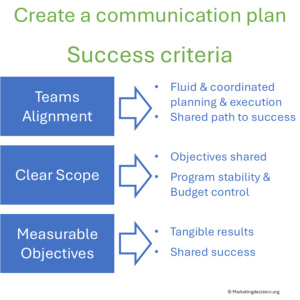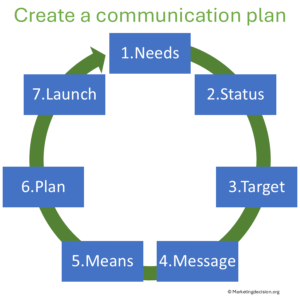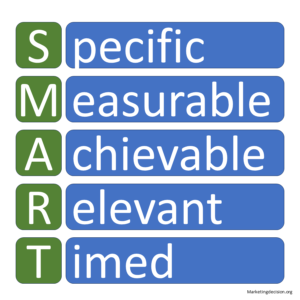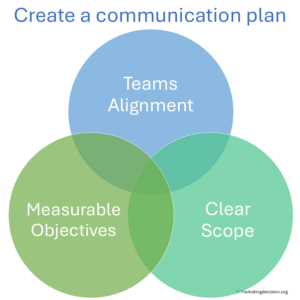A communication plan is essential to coordinate activities, align teams, and manage multiple communication channels effectively. It can be approached as a one-time effort or as a complex coordination across multiple teams and communication channels, always aligned with the company’s objectives and priorities.
The process begins with identifying the key elements of the program and, most importantly, understanding why the program is needed. The “why” ensures the plan aligns with the company’s mission and objectives. Asking “what success looks like?” is a practical way to create a plan that delivers results.
Before developing a communication plan, take time to clarify why it is needed and determine the factors that will measure its success. Address the “Why” before moving on to the “What” and “How” of communication.

Key questions to explore include:
How can we increase brand visibility?
What communication channels should we consider?
What is our current customer experience, and how can we improve it?
How can we enhance profitability?
What other needs or priorities must we address?
Ensuring the “Why” is well-articulated and visible to participants, stakeholders, and sponsors creates a strong foundation. These questions act as a guiding light throughout the plan’s development. By keeping them front and center, teams stay aligned and the plan can be executed effectively to achieve shared objectives.
When implementing a communication program, it is essential to build the following dimensions early on:
Ensure alignment among teams, stakeholders, and sponsors on the communication plan and its execution. Strong connections across teams are vital for smooth coordination and fluid implementation. Team success is crucial at all phases, so focus on aligning objectives and defining shared success metrics.
Clearly define the scope and timeline of the program. Break down complex projects into smaller, manageable components that fit within the overall communication plan. This approach provides a bird’s-eye view and facilitates the efficient use of multiple channels. Consider long-term, medium-term, and short-term goals.
Changes to the agreed-upon scope can derail a project, so it’s essential to maintain the original scope and avoid overcommitments.
Establish measurable objectives for each project and ensure they are visible across teams. Visibility promotes motivation and collaboration. Regularly evaluate performance to guide execution and extract insights for future program development.
These dimensions are critical for success. They help identify gaps between expectations and results, ensure smooth execution, enhance collaboration, and maintain control over budgets. Addressing these dimensions early on enables realistic objectives and confident program development.
Creating a communication plan involves multiple steps and iterative cycles. While budgets are often predetermined, they may allow room for negotiation and additional allocation. The development process typically evolves through several versions until a final program is selected for execution.

Keep the dimensions of Teams, Scope, and Measurable Objectives in focus throughout the process.
Objective: Understand the purpose and goals of the activity. Align the project with company objectives and ensure it is SMART (Specific, Measurable, Achievable, Relevant, and Time-bound). Motivate the communication team, sponsors, and stakeholders.
Objective: Review all components of the marketing mix to understand context and motivations. Share and discuss past efforts to clarify the project’s background and challenges.
Objective: Define the market segments targeted and identify other segments impacted by the communication. Ensure profiles are clear and communicated effectively.
Objective: Identify impactful messages for your market environment. Use the copy strategy to craft messages that focus on the promise, proof, benefit, tone, and residual message. Evaluate their impact on all relevant segments.
For more on copy strategy, see Sortlist – Copy Strategy.
Objective: Choose appropriate communication channels (e.g., PR, advertising, digital media). Assess costs and evaluate the return on investment (ROI).
Objective: Construct a detailed communication plan specifying who does what, when, and how. Plan deployment activities and potential responses during the launch.
Objective: Validate the communication program, set launch dates, and ensure teams are prepared. Activate the plan and engage teams for a successful rollout.
Here are some valuable resources to help you develop and refine your communication plan:
 SMART Acronym and Target Audience Tips
SMART Acronym and Target Audience Tips There are countless online resources with valuable advice on communication planning. When exploring them, always compare recommendations against your specific communication needs and the three critical dimensions: Teams, Program Scope, and Measurable Objectives.
There are countless online resources with valuable advice on communication planning. When exploring them, always compare recommendations against your specific communication needs and the three critical dimensions: Teams, Program Scope, and Measurable Objectives.
A well-orchestrated communication plan enables companies to succeed across market segments by leveraging multiple channels. Regular monitoring and adaptation of the plan are essential to address evolving needs and priorities effectively.
A communication plan typically includes three main components: aligned teams, a clearly defined program scope, and measurable objectives. Together, these ensure consistent messaging, effective coordination, and visibility across all communication activities.
Start by defining the purpose of the plan and understanding the “why” behind it. Then profile your target audiences, craft clear messages, select communication channels, and build a step-by-step schedule. A structured, measurable plan helps align teams and achieve company goals.
A well-designed communication plan enhances collaboration, strengthens brand visibility, and supports business priorities. By setting measurable objectives and maintaining alignment across teams, it ensures that every communication activity contributes to organizational success.
© marketingdecision.org
As mentioned in this chapter, many tools can help determine communication or promotional projects. SMART is one such tool that works well for small, targeted projects.
For more complex initiatives involving multiple actions, follow a clear process—such as the one proposed here—to ensure the communication plan is aligned with company objectives and fully supports the initiative under development.
The following section may include tools, some free, some with a fee to support this site development. If you consider a tool should be presented in this section and is missing, please let us know at: contact@marketingdecision.org
© 2025 MARKETING DECISION SOLUTIONS. All Rights Reserved.